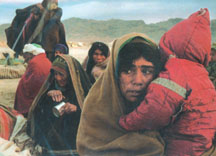
July 11 - World Population Day: Global focus on young people
'Taking Action With and For Young People' will be the theme for this
year's World Population Day, which is celebrated annually on July 11.
This theme, which focuses on the youth of the world, takes into account
the fact that the ideas, energy and determination of young people are
creating change around the world.
Half the global population is said to be under the age of 25, while
40 per cent of the population in 57 developing countries is under 15.
The number of youth surviving on less than a dollar a day was said to be
over 238 million (over 22 per cent of the population) in 2000. So, it's
not necessary to emphasise the importance of youth to the population
issue.

The United Nations Population Fund (UNFPA), which spearheads
celebrations around the world, works with young people and supports
their participation in population issues through various activities,
initiatives and programmes designed to build on and utilise the skills,
knowledge and enthusiasm of youth.
The UNFPA believes that getting young people involved in these
activities will increase their confidence, preparing them for the rights
and responsibilities of adulthood and citizenship. During past years
too, their contribution to the Day had been vast, through
awareness-raising activities like art, poster competitions and dramas.
World Population Day was inaugurated by the United Nations Population
Fund (UNFPA) in 1988 to mark July 11, 1987, when the global population
reached five billion. The day focuses attention on the urgency and
importance of population issues, particularly in the context of overall
development plans and programmes and the need to find solutions to these
issues.
The history of humans on Earth goes back over three million years,
and their early years as hunter/gatherers kept the population in check,
at around 10 million. It saw an expansion to over 300 million in 1AD and
increased further, to about a billion, during the industrial revolution
of the 18th century. The global population again saw a growth spurt
after the Second World War.
The world population was above 6.1 billion in 2000 and is expected to
surpass nine billion in another 50 years. The global population grew
faster than ever and faster than it's ever expected to grow in the
future, during the last 50 years. The majority of this growth between
2000 and 2030 is expected to take place in Africa, Asia and Latin
America.
The last census conducted in Sri Lanka in 2001 put the local
population around 19 million. However, the current population stands
closer to 20 million. It is expected to reach 21.5 million in 2015.
The UNFPA, which deals with population issues, is a development
agency that promotes the right of every man, woman and child to enjoy a
life of health and equal opportunity. It extends its support to
countries to use their population data for policies and programmes to
reduce poverty and improve the livelihoods of their people.
Dino exhibition
She has bird-like feet, a rather large rib cage and a surprisingly
elegant arch to her back.
But what big eyes and such terrifying razor teeth! She is a dinosaur
named Sue, one of the most amazing palaeontological discoveries of all
time.
Sue is part of an exhibition 'Dinosaurs! A T. rex Named Sue And
Friends', which is currently on at the Singapore Science Centre (SSC).
It features casts of two of the world's most complete and best preserved
skeletons - that of Sue, and a male, Stan - of the ferocious
Tyrannosaurus rex.
The exhibition, jointly hosted by the SSC and the National University
of Singapore, runs from May 20 to August 20. On the programme are
lectures by palaeontologists, as well as a display of dinosaur and plant
fossils and microfossils.
The Straits Times |


